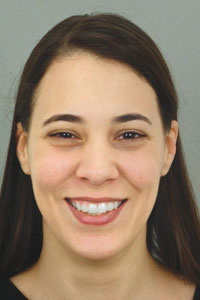Lisa DeBruine
 University of Aberdeen, UK
University of Aberdeen, UK
What does your research focus on?
Interpreting a wide range of signals from the face is at the center of social interaction. My original focus of research was on human kin recognition and how people respond to facial resemblance. As predicted by biological theories of inclusive fitness and inbreeding, I find that people perceive computer-generated facial resemblance as “trustworthy, but not lust-worthy”. This led to a productive second line of research on social perception of faces more generally, which has developed into further lines of research on social perception of voices and on the cognitive and visual processes that underpin face perception.
What drew you to this line of research? Why is it exciting to you?
I have always been fascinated by kinship and facial resemblance, possibly because I’m adopted. Being originally trained in biology, I knew that kinship is fundamental to many biological theories of social and sexual behavior and was excited by the potential for such theories to inform psychological research.
Who were/are your mentors or psychological influences?
I’ve been lucky to have excellent mentors at every stage of my career. My undergraduate thesis supervisor, Eugene Burnstein, helped me to realize that I love doing research as much as learning about it. During my masters, Bobbi Low encouraged my interest in evolutionary approaches to human behavior and introduced me to my eventual PhD supervisors, Margo Wilson and Martin Daly. They have been my most inspirational mentors; I hope someday to approach their success as scientists and teachers. Finally, the mentor for my NSF postdoctoral fellowship, David Perrett, is an amazing scientist and continues to have a huge influence on my work.
To what do you attribute your success in the science?
Two things have been essential to my scientific success: having a large collaborative network and working on my technical skills. Good collaborators bring together different skills and knowledge, making the whole much more than the sum of its parts. Being able to work on so many topics and having such a prolific output (I recently had my 100th paper accepted) wouldn’t be possible without my wonderful collaborators, especially Benedict Jones and Anthony Little. Another thing I’m really glad I did early in my career was to develop good programming skills. I focused on learning web and database programming so that I could put in place systems for my lab to catalog stimuli, set up experiments quickly, collect data online and in the lab, and store and organize data reliably and efficiently. This system allows my lab to be amazingly productive and lets us do projects that would otherwise be too expensive or time-consuming to consider, such as our investigation of the link between health and face preferences in several thousand women from 30 different countries and 50 U.S. states (DeBruine et al, 2010 & 2011 Proc Roy Soc B).
What’s your future research agenda?
I’m just about to start a two-year ESRC-funded project looking at the relationship between mate preferences measured in the lab and the actual partner choices people make out in the real world. I am also working to develop a general model of kin recognition, following a paper I recently published in PNAS that raised some interesting questions about current models of kin recognition.
Any advice for even younger psychological scientists? What would you tell someone just now entering graduate school or getting their PhD?
I would recommend to any scientist to consider approaches from other disciplines. My own work has really benefitted from theory and methods from biology, anthropology, and economics. I would also advise younger psychologists to devote time to developing technical skills. Finally, set up the infrastructure for your lab with your most ambitious future projects in mind.
What publication are you most proud of or feel has been most important to your career?
I am most proud of my recent paper in PNAS, which integrates my previous research on the social perception of facial resemblance with other influential work in kin recognition about the role of experience with siblings.
DeBruine, L. M., Jones, B. C., Watkins, C. D., Roberts, S. C., Little, A. C., Smith, F. G. & Quist, M. (2011). Opposite-sex siblings decrease attraction, but not prosocial attributions, to self-resembling opposite-sex faces. Proceedings of the National Academy of Sciences, 108, 11710-11714.
References
DeBruine, L. M., Jones, B. C., Crawford, J. R., Welling, L. L. M., & Little, A. C. (2010). The health of a nation predicts their mate preferences: Cross-cultural variation in women’s preferences for masculinized male faces. Proceedings of the Royal Society of London B, 277(1692): 2405-2410.
DeBruine, L. M., Jones, B. C., Little, A. C., Crawford, J. R. & Welling, L. L. M. (2011). Further evidence for regional variation in women’s masculinity preferences. Proceedings of the Royal Society of London B, 278(1707): 813-814.





APS regularly opens certain online articles for discussion on our website. Effective February 2021, you must be a logged-in APS member to post comments. By posting a comment, you agree to our Community Guidelines and the display of your profile information, including your name and affiliation. Any opinions, findings, conclusions, or recommendations present in article comments are those of the writers and do not necessarily reflect the views of APS or the article’s author. For more information, please see our Community Guidelines.
Please login with your APS account to comment.